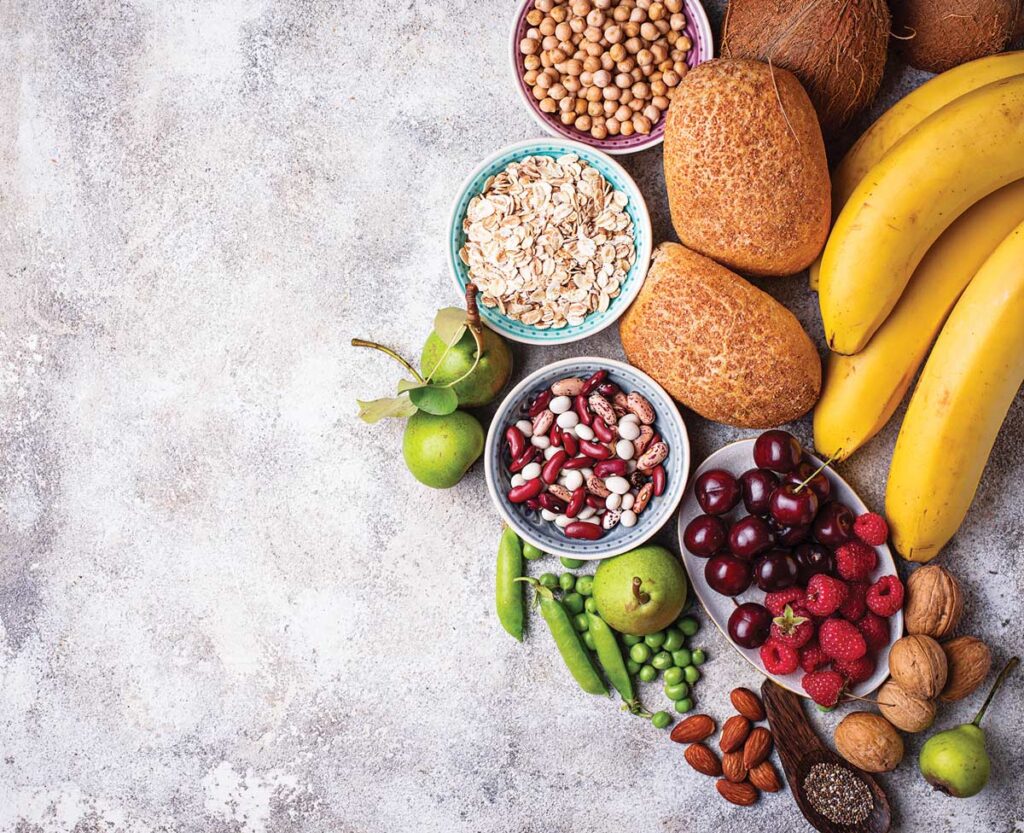
Fiber is a carbohydrate that cannot be digested by the small intestine but can be partially or fully fermented in the large intestine.1 Dietary fiber is an essential part of the diet, but most Americans do not consume enough. The average intake of dietary fiber in the United States (US) is 15 to 16g per day.1,2 The recommended dietary fiber intake is as follows:
- Women aged 19 to 50 years: 25g/day
- Women aged 51 years or older: 21g/day
- Men aged 19 to 50 years: 38g/day
- Men aged 51 years or older: 30g/day1
The Dietary Guidelines for Americans, 2020–2025 recommends consuming 14g of fiber per 1,000 calories.3
Types of fiber
There are two types of fiber: soluble and insoluble. Soluble fiber dissolves in water, forming a gel-like substance, and is fermented in the large intestine. Insoluble fiber cannot dissolve in water and is not fermented in the large intestine. Soluble fiber affects glucose and cholesterol levels, whereas insoluble fiber plays a role in bowel movements and the formation of stool.1,4
Sources of soluble fiber include oats, barley, beans, peas, legumes, fruits, and root vegetables. Sources of insoluble fiber include wheat bran, whole grains, nuts, potatoes, apple skins, cauliflower, and many green vegetables.1,2
High-fiber Foods
Below is a short list of common high-fiber foods and their fiber content:
- High-fiber cereal: 14g per ½ cup
- Artichoke: 9.6g per cup
- Navy beans: 9.6g per ½ cup
- Green peas: 8.8g per cup
- Raspberries: 8g per cup
- Lentils: 7.8g per cup
- Brussels sprouts: 6.4g per cup
- Bran flakes: 5.5g per ¾ cup
- Broccoli: 5.2g per cup
- Apple (with skin, medium): 4.8g
- Bulgur: 4.1g per cup
- Chia seeds: 4.1g per Tbsp
- Almonds: 3.5g per ounce
- Banana (medium): 3.2g5
Impact on Health
Bowel and gastrointestinal health. Fiber helps maintain normal bowel movements, absorbing water to soften and bulk up stool. Soft, bulky stool is easier to pass, which helps prevent constipation. Bulking also prevents the formation of loose stool.1,6,7 It is also important to drink plenty of water with a high-fiber diet to ensure it has the proper effects on stool.6 In addition, high-fiber diets can reduce the risk of hemorrhoids and diverticular disease.1,6 A high-fiber diet might reduce the risk of colorectal cancer,1,6,7 potentially due to the dilution of fecal carcinogen/procarcinogen concentrations and reduced absorption of carcinogens in the lower gastrointestinal tract.7 High-fiber diets are associated with increased gut microbiota diversity as well.7
Metabolic health. Fiber consumption slows the absorption of glucose, thereby stabilizing blood sugar levels after meals.1,6,7 High fiber intake is also associated with a decreased risk of Type 2 diabetes1,2,6,7 and greater satiety.1,7
Cardiovascular health. Fiber plays a big role in cardiovascular health. High soluble fiber intake is associated with reductions in cholesterol.1,2,6,7 Furthermore, fiber can help protect against hypertension, cardiovascular disease (CVD), and stroke.1,2,7 One study showed that soluble fiber supplementation led to improvements in both systolic and diastolic blood pressure.8 According to a review article, there was a moderate certainty of evidence to indicate that higher dietary fiber intake reduced the risk of all-cause mortality among individuals with CVD. Among people with hypertension, there was a high certainty of evidence that higher fiber intake improved systolic and diastolic blood pressure and a moderate certainty of evidence that higher fiber intake improved fasting plasma glucose levels.9
Adverse effects. Going from a low- to high-fiber diet can cause flatulence, abdominal bloating, and cramps. Gradually adding fiber into the diet can prevent or minimize these effects.2
Fiber Supplements
Although it is typically better to get fiber from whole food sources, as they have better nutrient profiles,6 supplements can be taken to help you reach the recommended daily fiber intake. There are different types of supplements, including powders, pills, and gummies.10 Types of fiber in supplements include psyllium, inulin, acacia gum, polydextrose, maltodextrin, methylcellulose, and calcium polycarbophil.2,10 Fiber supplements might also contain sugar or other additives.10
Tips to add more fiber to your diet
Replace refined grains with whole grains.
Keep fresh or frozen fruits and vegetables on hand to add fiber to any meal; for example, quickly microwave frozen broccoli to go with dinner, or pour fresh raspberries into your morning oatmeal or cereal.
Eat more high-fiber, plant-based proteins (e.g., beans, lentils).
Snack on fruits, vegetables, and whole grain foods.2,4,6
Editor’s note. Consult with a healthcare professional to determine how best to implement fiber into your diet.
Sources
- Akbar A, Shreenath AP. High fiber diet. Updated 1 May 2023. In: StatPearls. StatPearls Publishing; 2024. https://www.ncbi.nlm.nih.gov/books/NBK559033/. Accessed 26 Mar 2024.
- NIH News in Health. Rough up your diet: fit more fiber into your day. https://newsinhealth.nih.gov/special-issues/eating/rough-up-your-diet. Accessed 19 Mar 2024.
- US Department of Agriculture, US Department of Health and Human Services. Dietary Guidelines for Americans, 2020–2025. 9th edition. Dec 2020. https://www.dietaryguidelines.gov/sites/default/files/2021-03/Dietary_Guidelines_for_Americans-2020-2025.pdf. Accessed 19 Mar 2024.
- US Food and Drug Administration. Interactive nutrition facts label – dietary fiber. Oct 2021. https://www.accessdata.fda.gov/scripts/interactivenutritionfactslabel/assets/InteractiveNFL_DietaryFiber_October2021.pdf. Accessed 19 Mar 2024.
- US Department of Agriculture, US Department of Health and Human Services. Food sources of dietary fiber. Dietary Guidelines for Americans. https://www.dietaryguidelines.gov/resources/2020-2025-dietary-guidelines-online-materials/food-sources-select-nutrients/food-0. Accessed 19 Mar 2024.
- Mayo Clinic Staff. Dietary fiber: essential for a healthy diet. Mayo Clinic. 4 Nov 2022. https://www.mayoclinic.org/healthy-lifestyle/nutrition-and-healthy-eating/in-depth/fiber/art-20043983. Accessed 19 Mar 2024.
- P NPV, Joye IJ. Dietary fibre from whole grains and their benefits on metabolic health. Nutrients. 2020;12(10):3045.
- Ghavami A, Banpouri S, Ziaei R, et al. Effect of soluble fiber on blood pressure in adults: a systematic review and dose-response meta-analysis of randomized controlled trials. Nutr J. 2023;22(1):51.
- Reynolds AN, Akerman A, Kumar S, et al. Dietary fibre in hypertension and cardiovascular disease management: systematic review and meta-analyses. BMC Med. 2022;20(1):139.
- Cleveland Clinic. How do I choose the best fiber supplement? 28 Jun 2023. https://health.clevelandclinic.org/best-fiber-supplements. Accessed 19 Mar 2024.




